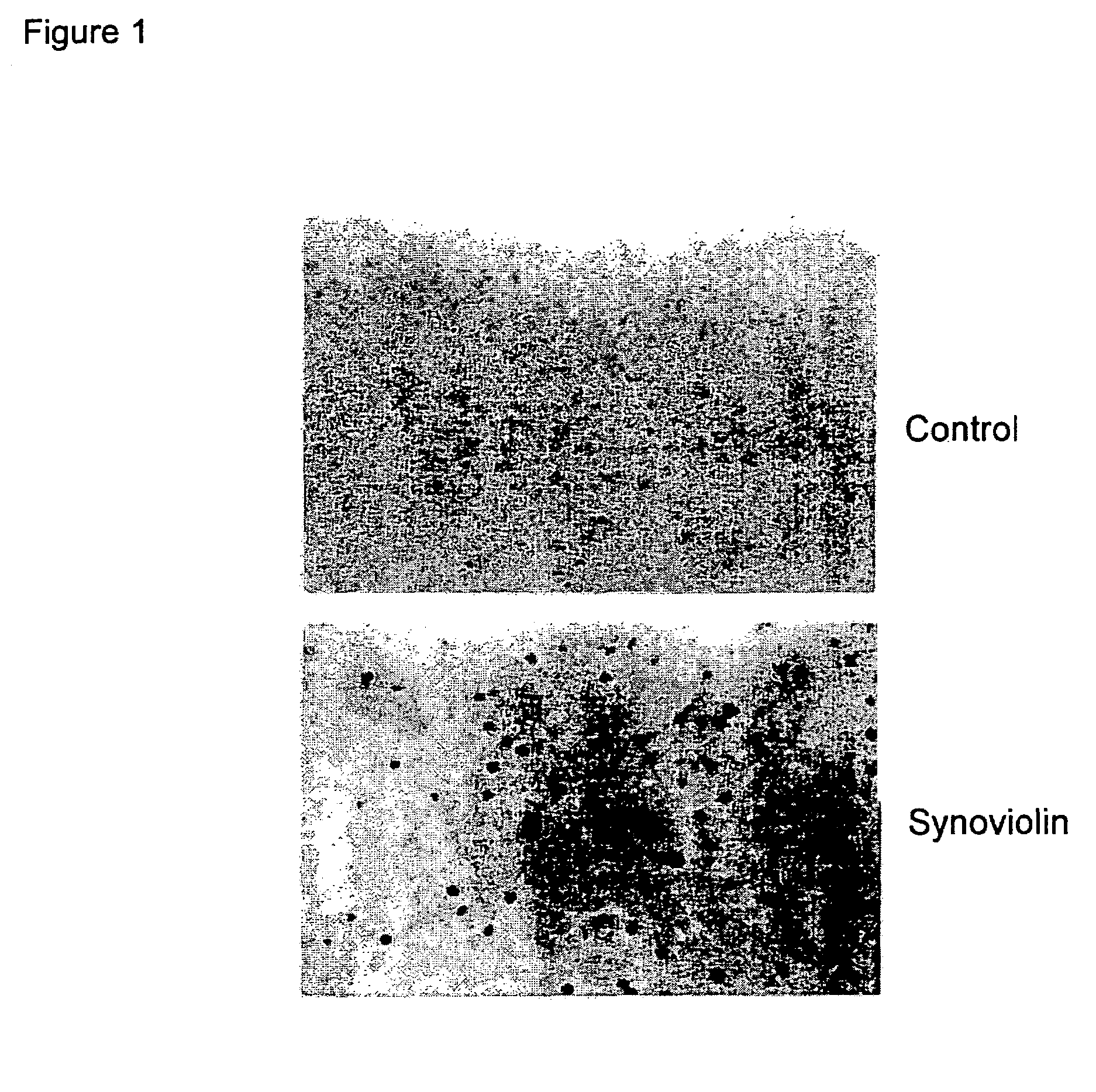Synovial cell protein
- Summary
- Abstract
- Description
- Claims
- Application Information
AI Technical Summary
Benefits of technology
Problems solved by technology
Method used
Image
Examples
Example
EXAMPLE 1
Preparation of Anti-Synovial Cell Anti-Serum
[0300]Anti-synovial cell anti-serum was obtained using, as an immunogen, synovial cells prepared by the following procedure. Synovial tissue extracted by synovectomy from ten rheumatoid arthritis (RA) patients was washed in phosphate buffered saline (PBS) in a sterile state. The washed tissue was cut to a size of approximately 5 mm square and 0.25% trypsin / PBS digestion was performed at 37° C. for 20 minutes. Excess tissue lumps were removed from the digested synovial tissue and the cells thus obtained were suspended in Dulbecco's modified Eagle's medium containing 10% fetal calf serum (Virology (1959) 8:396) (10% FCS-DMEM) and cultured for 24 hours in a sterilized cell culture Petri dish under 5% CO2 at 37° C. The culture supernatant was discarded, washing was performed using 10% FCS-DMEM, and the non-adhering cells were removed to obtain rheumatism patient-derived synovial cells as cells adhered to the Petri dish (The Journal of...
Example
EXAMPLE 2
Gene Cloning of an Antigen (Synoviolin) Recognized by Anti-Synovial Cell Anti-Serum
[0303]The acid guanidine / phenol chloroform method was used to extract the total RNA from the synovial cells of ten RA patients obtained in Example 1, and poly T beads were used to purify the mRNA (Analytical Biochemistry, 162, 159, 1987). The λZAP vector (Stratagene) was used to prepare a cDNA library of RA patient synovial cells by the ordinary method. A picoBlue immunoscreening kit (Stratagene) was used to perform immunoscreening with the anti-synovial cell anti-serum of Example 1 above (FIG. 1). The positive clone (phage) thus obtained was converted to a plasmid pBluescript II SK (+) with a helper phage. The nucleotide sequence of the DNA inserted into the pBluescript II SK (+) was determined with an ABI PRISM 377 DNA Sequencer (PERKIN ELMER) using M13PrimerM4 and M13PrimerRV (Takara) based on the dye terminator method (Proc. Natl. Acad. Sci. USA. (1977) 74:5463). The nucleotide sequence w...
Example
EXAMPLE 3
Expression of Partial Synoviolin Recombinant Protein in E. coli
[0304]From a cDNA clone obtained by immunoscreening using anti-synovial cell anti-serum, cDNA that encodes a portion of Synoviolin (1799 bp; SEQ ID NO: 1, No. 1233-3031) was treated with the restriction enzymes EcoRI and XhoI and extracted. The cDNA which has a sequence recognized by EcoRI / XhoI at its ends was inserted into the glutathione S-transferase (GST) fusion protein expression vector pGEX-5X-3 and subcloning was performed. pGEX-5X-3 into which a portion of the synoviolin cDNA was inserted was introduced into the BL21 E. coli strain by 45-second heat shock at 42° C. to obtain BL21 / synoviolin-GST gene / pGEX-5X-3. This BL21 was cultured in an LB medium containing 0.1 mg / mL ampicillin, 0.1 mM isopropylthio-β-D-galactoside (IPTG) was added, and it was cultured for an additional 2 hours at 37° C. to induce the expression of the aforementioned fusion protein. After the BL21 recovered by centrifugation was washe...
PUM
 Login to View More
Login to View More Abstract
Description
Claims
Application Information
 Login to View More
Login to View More - R&D
- Intellectual Property
- Life Sciences
- Materials
- Tech Scout
- Unparalleled Data Quality
- Higher Quality Content
- 60% Fewer Hallucinations
Browse by: Latest US Patents, China's latest patents, Technical Efficacy Thesaurus, Application Domain, Technology Topic, Popular Technical Reports.
© 2025 PatSnap. All rights reserved.Legal|Privacy policy|Modern Slavery Act Transparency Statement|Sitemap|About US| Contact US: help@patsnap.com



